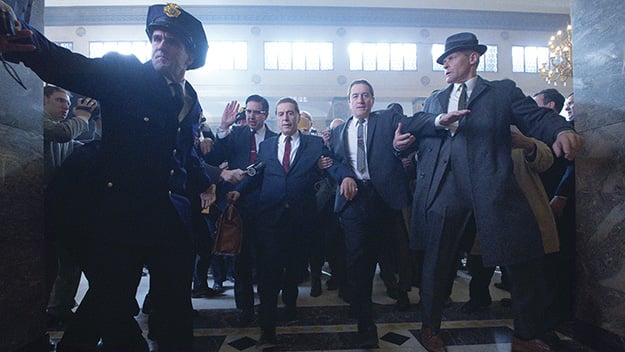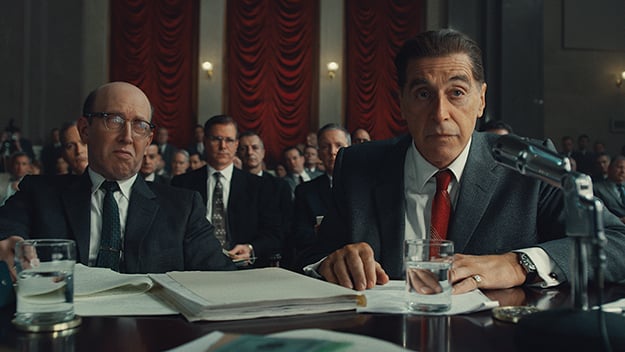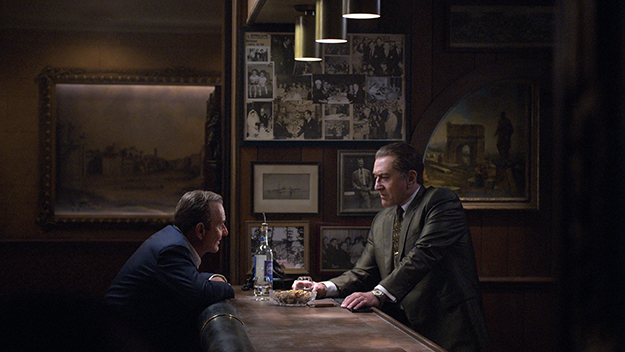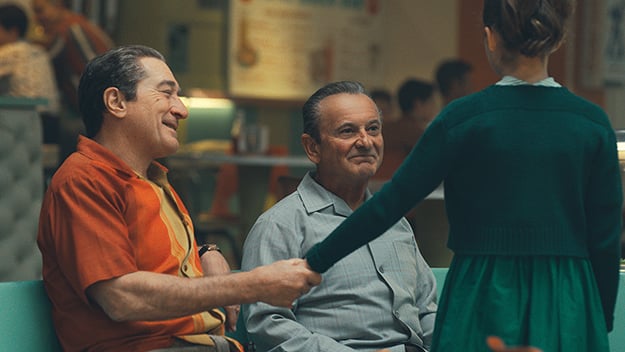Film of the Week: The Irishman

Images from The Irishman (Martin Scorsese, 2019)
Martin Scorsese’s The Irishman is an extraordinary feat of rejuvenation, and not just because of the digital effects that turned its lead actors back into young(ish) men. That technology might have been the focus of much of the film’s publicity, as well as accounting in large part for the film’s hefty $150 million budget—the main reason why The Irishman ended up financed by Netflix instead of the established studios. Removing the effects of time from Robert De Niro, Joe Pesci (both 75), Al Pacino (79) and Harvey Keitel (80) might have been a key consideration for Scorsese, the film’s very DNA in a sense. But it’s not something that need worry the viewer for too long, at least not after an early shot of De Niro’s union man turned mobster Frank Sheeran at the wheel of his truck—smooth-faced but physically bulky, wearing a leather jacket as if he’d been stuffed into it.
The odd thing about the film is that—despite Scorsese’s engagement of a “movement analyst”—the “youthified” actors still move somewhat like older men, carrying themselves with a heft that they never had in their wiry prime. Yet there’s something appropriate about that discrepancy—which for the most part you register almost subliminally, if at all. This is a film about the gulf between youth and age, innocence (relative innocence only) and experience. Framed as Frank Sheeran’s narration of his career, The Irishman is a story told by an old man about a younger self who from the start is already burdened with the inevitability of what he will become, of the soul death he will undergo in the course of his career. Meanwhile, in the case of Sheeran’s boss and eventual victim Jimmy Hoffa, played by Pacino, simply to mention the man is to invoke the mysterious death that he would end up becoming most famous for. Even in their prime, these men were already dead—and the film’s digital effects make them carry that marked status from the start.
But The Irishman is an act of rejuvenation for Scorsese too—it’s his most thoroughly alive film in years. It sees the director doing one of the things (many would argue, the thing) that he’s best at, telling a story about individuals and their place in the system of organized crime. The film rounds off what now looks like a trilogy, complementing GoodFellas and Casino (you could argue for Mean Streets as a first chapter, or a more intimate prelude). But it’s not just about Scorsese and the old gang returning to earlier triumphs: the film has a completeness, a sense of necessity that’s been lacking in his work for the last couple of decades.
The Irishman answers the question—theoretically, at least—that’s been part of American mythology for years: the enigma of what really happened to one-time Teamsters Union leader James Riddle Hoffa after his disappearance in July 1975. One answer, although there has been much debate about its veracity, was provided in a 2004 book by Charles Brandt, I Heard You Paint Houses, based on interviews with Frank Sheeran, a union official and mob associate who claimed that he killed Hoffa at the behest of his Mafia bosses. The Irishman isn’t specifically the story of the supposed killing, but rather an account of Sheeran’s criminal apprenticeship and career. It’s also about the way a certain criminal system operates: like Casino, it features a boldly extensive De Niro voice-over explaining exactly how things work, and challenging us to keep up with the details. Steven Zaillian’s script is crammed with social detail, insights into delicate, contradictory moral codes, and telling idiosyncrasies of language. That includes a phrase that could catch on like The Godfather’s “offer he can’t refuse”—“It is what it is,” signifying an unavoidable death sentence—as well as the discreet “a little concerned” to denote that the organization is in fact very concerned, murderously so.

All roads in The Irishman lead to death, and indeed the film begins with imminent death, as Rodrigo Prieto’s camera creeps along the corridor of a retirement home to the Five Satins’ ballad “In the Still of the Night.” De Niro, wizened in effective prosthetic make-up, is an octogenarian Frank facing his end and telling his story to an unseen interlocutor—a stand-in for Brandt, or a TV interviewer, or perhaps just Frank talking to himself. The narrative within the narrative begins with Frank and his mentor, mob capo Russell Bufalino (Pesci) in a car with their wives, en route to a wedding in 1975. The women demand a cigarette break: Frank notices that they’ve come to the same rest stop where, as a truck driver, he first met Russell years earlier.
The film takes us through Frank’s introduction to gang life, first making himself useful to mobsters by conveniently “disappearing” cuts of meat from the consignments he’s carrying: when this practice lands him in court, Russell’s attorney cousin (a sly Ray Romano) gets him off the hook with shameless chutzpah. We also see something of Frank’s wartime career in Italy, calmly performing the summary executions of German soldiers—something we’re given to understand was standard practice. It’s not suggested that such incidents make Frank what he later becomes, nor that he’s in any way exceptional: what’s implied is that the capacity for such merciless action is more closely woven into the workings of modern respectable society than we might like to believe. This is has been a theme of Scorsese’s cinema since the start: the idea that beneath the visible surfaces of business and politics, sharks are swimming. This was the tenor of Casino, showing the horror behind the Las Vegas neon, and it’s the essence of The Irishman, Scorsese’s “secret history” movie. Like James Ellroy, he’s interested in the hidden intersections between criminal activity and headline news: this is a mob chronicle, but it’s also about the Bay of Pigs, the Kennedy assassination and, above all, the disappearance of Hoffa.
Frank settles for keeps into his criminal role once he starts “painting houses”—a euphemism for shooting people, i.e. spraying their walls red. This image and the underworld routineness of it emerges neatly in an early vignette as a younger Russell returns to his comfortable but unassuming home from a day’s work, his shirt splashed crimson; his wife doesn’t turn a hair but then, we’re told, she comes from mob royalty. Frank starts out with assorted “little things to do” for Russell and for Angelo Bruno (Keitel)—and one of the things that makes the film fresh is to see De Niro switch from his elder statesman roles in GoodFellas and Casino to become a gofer, an earnest and humble subordinate, one who doesn’t always have much choice in his actions, and who sometimes screws up. There’s a wonderful moment early on when he misreads the criminal code, taking on a side job for a man named Whispers—a faux pas he’s required to correct in suitably drastic fashion.

Eventually, endorsed by the organization, Frank gets the call from Hoffa: “Do you want to be part of history?” says the union boss, with unknowing irony. At this point, Frank reminds us, Hoffa was a national idol: “In the ’50s, he was like Elvis… In the ’60s he was bigger than the Beatles.” As president of the International Brotherhood of Teamsters, Hoffa is a magnetic public speaker, a ranter of mesmerizing presence with an ear for a slogan: “If you got it, a truck brought it to you.” Frank becomes his right hand man, his protecting presence: they sit in their pyjamas together in Hoffa’s hotel room, a disarmingly domestic pair. Hoffa becomes part of Frank’s life: a key thread shows how Frank’s daughter Peggy (played as a girl by Lucy Gallina) warms to Hoffa as an adoptive uncle, but shies away from Russell, establishing a subtle theme of jealousy and rejection, perhaps showing another reason why Hoffa was only tolerated by the Mafia for so long.
While Frank consolidates his position in the world, Hoffa’s falls apart. The Teamster is tried and imprisoned on a bribery charge; released in 1971, he demands his status back as if it were his birthright: “This is my union.” With his populist bumptiousness and quasi-regal entitlement, it’s impossible not to see parallels with Trump, especially with Pacino mischievously pitching him as a self-conscious, almost self-caricaturing vaudeville turn. Hoffa becomes a raging loose cannon, an embarrassment for his criminal associates. Pacino—who, toilet brush hair apart, looks nothing like the real Hoffa—gives a monstrously good performance, relishing the part and the comedy in it, especially when that comedy is black. About to be driven to his doom in a vehicle that has recently contained a frozen fish, Hoffa starts pontificating, “Never put a fish in your car.” It’s one of several witty scenes in which the repetitions and non-sequiturs of Zaillian’s dialogue carry pungent overtones of David Mamet—and Pacino, of course, knows his Mamet.
With his indefatigable, showboating belligerence, Hoffa is Pacino’s best performances in ages; the actor takes the buffoonishness that is often his Achilles heel and makes it resonate, as an imperial narcissist who can’t believe he isn’t indestructible. Never, the film suggests, did a man sign his own death sentence with such a flamboyant flourish. What’s striking in The Irishman is that it’s the legitimate public figure who’s a beacon of noise and crassness, while most of the mobsters are the epitome of discretion and decorum. A neat reversal is that Pesci, celebrated for his brash, twitchy monsters, now plays a muted doyen, an avuncular figure of calm ruefulness; Pesci is wonderfully delicate in the role, speaking with gently pained tones as Russell pronounces a fatal verdict with a subliminal wince of discomfort.
De Niro’s Frank is similarly an embodiment of quiet normality, keeping the man’s violence coolly wrapped under the surface of quiet efficiency. The notable exception is a scene in which Frank punishes a shopkeeper who has humiliated his daughter Peggy—a scene of shockingly uncontrolled but utterly mundane brutality that is key to the film. It’s the only violence Frank performs out of personal anger, and it wrecks his relationship with Peggy right there and then.

There’s very little said between Frank and Peggy—indeed Anna Paquin, who plays her as an adult, barely speaks at all. The wives of the men in this story are almost as silent—Josephine Hoffa (Welker White) gets a somewhat better deal, and a key scene towards the end—but the near-absence of women, in contrast to their central roles in GoodFellas and Casino—is the point. This is a film about history being made—ruinously–and being stolen by violent, venal men while women’s lives are marginalized and damaged. Paquin’s Peggy may not speak, but her silent, accusing looks constitute some of the most potent acting here, especially in a scene where she simply walks away from her now aged father—an act that is arguably the film’s most merciless and definitive death sentence.
With its unbounded energy, The Irishman feels like the work of a young, hungry—no, voracious—director. But it also exudes a sorrowful wisdom that comes with age; it sometimes moves slowly, deliberately, in tune with the physical weight underlying these veteran actors’ performances as younger men. We’re miles from the manic edge of youth in Scorsese’s earliest De Niro films, and from the phony attractions of the good life depicted in his other mob pictures: instead of Henry Hill’s big night at the Copacabana, the only hint of celebration here is a dour gala at which the Teamsters honour Frank’s long service, an event underscored by fatalistic regret. This is not the first film in which Scorsese muses on the moral and theological dilemma of gaining the whole world and losing your own soul (The Aviator was another). Implicitly, the film is its hero’s extended confessional, long before Frank’s priest shows up in the final act and tries to coax a hint of remorse from a man who’s perhaps too broken to find even that in himself.
Jonathan Romney is a contributing editor to Film Comment and writes the Film of the Week column. He is a member of the London Film Critics Circle.







